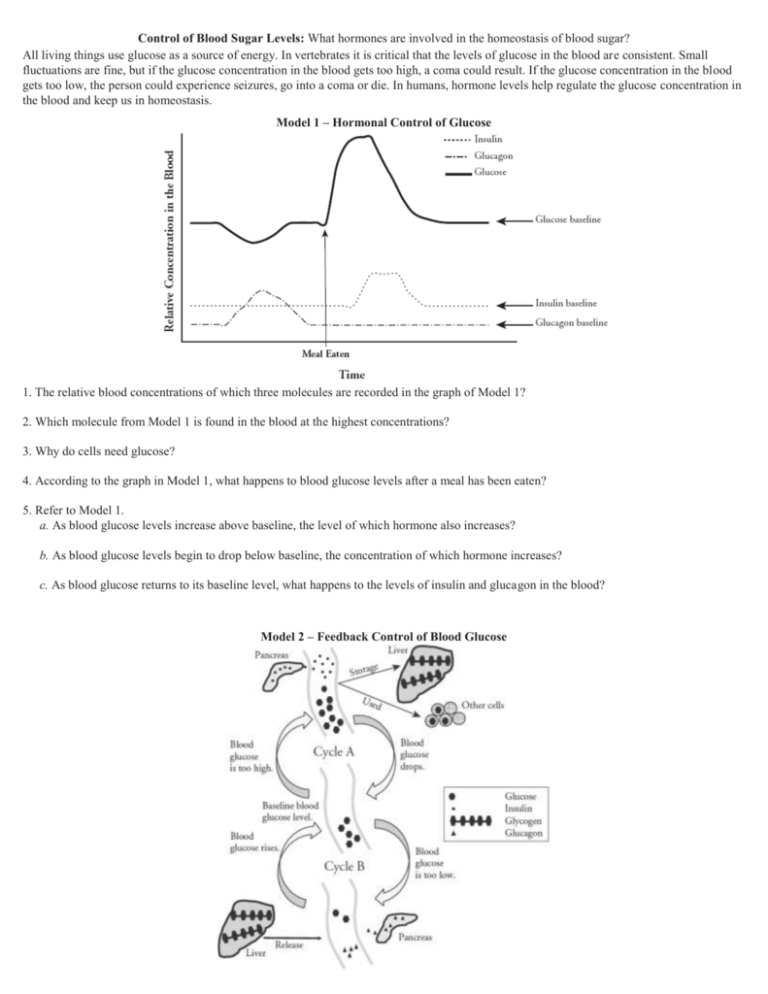Blood Sugar Levels
advertisement

Control of Blood Sugar Levels: What hormones are involved in the homeostasis of blood sugar? All living things use glucose as a source of energy. In vertebrates it is critical that the levels of glucose in the blood are consistent. Small fluctuations are fine, but if the glucose concentration in the blood gets too high, a coma could result. If the glucose concentration in the blood gets too low, the person could experience seizures, go into a coma or die. In humans, hormone levels help regulate the glucose concentration in the blood and keep us in homeostasis. Model 1 – Hormonal Control of Glucose 1. The relative blood concentrations of which three molecules are recorded in the graph of Model 1? 2. Which molecule from Model 1 is found in the blood at the highest concentrations? 3. Why do cells need glucose? 4. According to the graph in Model 1, what happens to blood glucose levels after a meal has been eaten? 5. Refer to Model 1. a. As blood glucose levels increase above baseline, the level of which hormone also increases? b. As blood glucose levels begin to drop below baseline, the concentration of which hormone increases? c. As blood glucose returns to its baseline level, what happens to the levels of insulin and glucagon in the blood? Model 2 – Feedback Control of Blood Glucose 6. According to Model 2, what are three of the organs/tissues of the body that interact to regulate blood glucose levels? 7. According to Model 2, where in the body do the insulin and glucagon originate? 8. Refer to Model 2. a. What shape in the model represents glucose? b. Describe how glycogen is related to glucose. c. Which form of sugar, glucose or glycogen is stored in the liver for future use? Read This! Most cells in the body have insulin receptors. When insulin is present, the transfer of glucose into cells increases. This takes the glucose out of the bloodstream and puts it where it can be used, or in some cases stores it as glycogen. The glycogen can be converted back into glucose when it is needed. But glycogen cannot be used by cells directly as an energy source. Excess glucose that remains in the blood gets excreted out in urine. 9. Refer to Model 2. a. In which cycle is glucose removed from the blood by storing it or moving it into cells to use for fuel? b. Which hormone, insulin or glycogen, helps glucose move into cells of the body? c. In which cycle is glucose added to the blood from storage areas? d. Which hormone, insulin or glucagon, helps turn glycogen into glucose? 10. In grammatically correct sentences, explain the role of insulin in maintaining glucose levels after a large meal. 11. In grammatically correct sentences, explain the role of glucagon in maintaining glucose levels when the organism is hungry. 12. For each of the cycles in Model 2 identify the stimulus and response for the feedback loops and indicate whether the feedback loop is positive or negative feedback. Stimulus Response Cycle A Cycle B 13. Predict the levels of glucose, glucagon, and insulin in a person who has: a. Skipped a meal. Positive or Negative? b. Just run 5 miles. c. Just ate a large dinner. 14. In the past, diabetes mellitis was diagnosed by tasting the urine of the patient. What evidence for diabetes were the doctors looking for? 15. In Type I diabetes, the Beta cells of the pancreas produce little to no insulin. What effect does this have on an organism’s ability to regulate blood glucose levels? 16. Type I diabetics must eat frequent small meals. Explain why this is necessary using what you have learned about blood glucose regulation. 17. Other symptoms of Type I diabetes are increased thirst and frequent urination. Explain these symptoms using what you have learned in this activity as well as your knowledge of osmosis and diffusion. 18. Type II diabetes shares many of the same symptoms as Type I diabetes. Using your textbook and/or a computer, research the cause of this type of diabetes.




